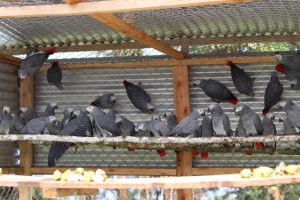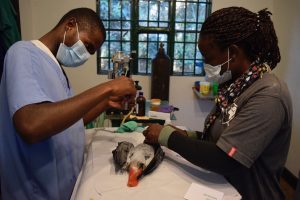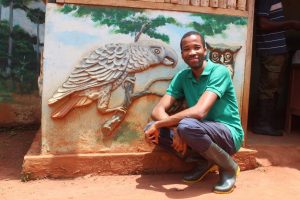
Africa is the native land to several old-world parrot species. This month we will look at the ongoing work to protect the Congo African grey in Nigeria and the Democratic Republic of Congo (DRC). These parrots are quite beloved and famed in captivity, but their very existence in Africa is in serious jeopardy. While the population has been rapidly collapsing, the current yet risky efforts to preserve this species are having some moderate success. However, more needs to be done, and soon! In 2016, Congo African greys were listed as “endangered” on the IUCN (International Union for Conservation of Nature) Red List of Threatened Species, and placed on Appendix I of CITIES (the Convention on International Trade in Endangered Species of Wild Species of Fauna and Flora).
Greys in Peril
By some official counts, over 1.2 million wild African greys have entered international trade over the last 40 years. That marks a huge dent in the population, and of course many do not survive the trip to their final commercial destination. Like many challenged species, their habitats are also now fragmented, which has implications for genetic diversity, food sources, and overall population growth. Unfortunately, it’s now very rare to find large roosting groups.

Here are some of the projects underway in an attempt to make a future difference.
Surveying Greys in Nigeria
In Nigeria, surveys have been conducted at 28 sites throughout the country’s forests by the World Parrot Trust and local partners since 2018. These surveys have found a steep decline in the African grey population due to continued trapping, while in other areas without trapping the population is more resilient. That’s hopeful! These surveys also help to engage local communities, building the foundation for community-based conservation at key sites, which is absolutely essential to the success of any conservation effort. Nigeria has been a leader in securing protections for the greys. However, that message has not found its way to enough traders and consumers in some regions, and enacted laws are not yet well enforced. It is a hard work in progress, and COVID has added to that challenge.

Saving Greys in the Democratic Republic of Congo
In the DRC, while efforts to dismantle illegal trafficking networks are beginning to take effect with multiple groups of parrots seized from traders, several hundred greys are still being trapped each month. The World Parrot Trust works with local authorities and rescue centers to provide emergency veterinary care for the birds that can be saved, and to improve rehabilitation and release programs. The good news—within the last year, three Congolese veterinarians have been trained to help with seizure cases to decrease the mortality rates, and an additional rehabilitation aviary was built to receive birds from three major seizures. In November 2020, the first group was released from the rehab facility, marking a major step forward towards sustaining the African grey population in the DRC.

The key to success in both of these countries is a commitment from the local population to protect these birds as part of their heritage, preserve the forest lands needed, and find sustainable sources of income. Last fall, the DRC began making regular announcements on local radio stations to raise awareness about the plight of grey parrots, a hopeful step in the right direction.

Lafeber’s $500 GLOBAL PARROT conservation grant this month goes to a new community-based initiative to monitor and protect nests at an essential breeding area in Nigeria using newly trained and employed former parrot trappers. These sites were recently identified during surveys in coastal Nigeria. You can also help this new and important initiative. For more information or to make a tax-deductible donation, go to: https://www.parrots.org/donate. Earmark your donation specifically for Congo African greys.
